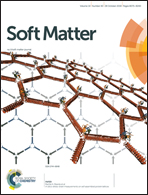Modeling the relative dynamics of DNA-coated colloids†
Abstract
We construct a theoretical model for the dynamics of a microscale colloidal particle, modeled as an interval, moving horizontally on a DNA-coated surface, modelled as a line coated with springs that can stick to the interval. Averaging over the fast DNA dynamics leads to an evolution equation for the particle in isolation, which contains both friction and diffusion. The DNA-induced friction coefficient depends on the physical properties of the DNA, and substituting parameter values typical of a 1 μm colloid coated densely with weakly interacting DNA gives a coefficient about 100 times larger than the corresponding coefficient of hydrodynamic friction. We use a mean-field extension of the model to higher dimensions to estimate the friction tensor for a disc rotating and translating horizontally along a line. When the DNA strands are very stiff and short, the friction coefficient for the disc rolling approaches zero while the friction for the disc sliding remains large. Together, these results could have significant implications for the dynamics of DNA-coated colloids or other ligand-receptor systems, implying that DNA-induced friction between colloids can be stronger than hydrodynamic friction and should be incorporated into simulations, and that it depends nontrivially on the type of relative motion, possibly causing the particles to assemble into out-of-equilibrium metastable states governed by the pathways with the least friction.



 Please wait while we load your content...
Please wait while we load your content...